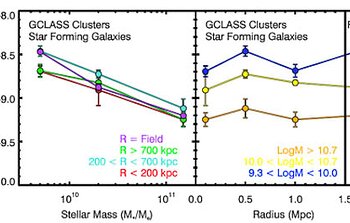Quenching Star Formation at z~1: Nature vs. Nurture
January 25, 2012

Results from the Gemini Cluster Astrophysics Spectroscopic Survey (GCLASS) reveal that galaxies at a redshift of about one have at least two reasons for the curtailment of star formation. In a paper accepted in The Astrophysical Journal lead author Adam Muzzin and collaborators conclude that both mass and environment play a role in determining when a galaxy’s star formation is snuffed out.
Does galaxy formation depend mostly on nature or nurture? In other words, is it primarily a self-regulated process, controlled by properties of the galaxies themselves such as their total stellar mass (i.e., “nature”), or is controlled by processes external to the galaxies such as the environment they live in (i.e., “nurture”)? In the nearby universe we know that both factors are important but at redshifts z ~ 1, when the universe was only ~40% of its current age and large-scale environments were just in the process of forming, the importance of environment in shaping the galaxy population is not well understood.
Adam Muzzin (Yale University and Leiden Observatory, The Netherlands) and collaborators have used the Gemini Multi-Object Spectrograph (GMOS) instruments on both Gemini North and South to perform extensive spectroscopy of galaxies in 10 massive galaxy clusters at z = 1. This survey, the Gemini Cluster Astrophysics Spectroscopic Survey (GCLASS), is the first to study a large number of massive high-redshift clusters in such detail. The GMOS spectroscopy is critical because it allows the team to accurately determine which galaxies belong to the clusters and to measure the star formation rates (SFRs) of those galaxies.
The results from the first GCLASS paper, now accepted for publication in The Astrophysical Journal, show that even when controlling for the fact that galaxies with larger masses live in higher-density environments such as clusters, it is clear that both mass and environment are independently responsible for ending star formation in galaxies at z=1. This is demonstrated in Figure 1. In the left panel it shows the fraction of star-forming galaxies as a function of their stellar mass for galaxies at different clustercentric radii. In the right panel of Figure 1 the complement is shown, specifically, the fraction of star forming galaxies as a function of cluster-centric radius for different stellar mass ranges.
The results are more surprising when the stellar populations of those galaxies are examined. Figure 2 shows the SFR per unit stellar mass (the specific star formation rate; SSFR) for the star forming galaxies as a function of stellar mass at different clustercentric radii (left panel), and as a function of clustercentric radii in different for different stellar masses (right panel). It appears that the SSFRs of star-forming galaxies are controlled only by their stellar mass, not by their environment. While both stellar mass and environment determine whether a galaxy is “on” (i.e., forming stars), once they are “on,” the rate at which they consume gas and form stars is completely self-regulated by their mass.
Understanding how environment can be responsible for quenching star formation without leaving an imprint on the stellar populations of a galaxy is challenging. The GCLASS team argues that the simplest explanation is that the timescale over which environment truncates star formation is extremely rapid. If so, galaxies will move quickly off the SSFR-mass relation (Figure 2, left panel) and it would explain the lack of a correlation between the SSFRs of star-forming galaxies and their environment. To test this interpretation, they searched the data for galaxies that had a “poststarburst” spectrum. They found that galaxies with poststarburst spectra were 3 times more common in the cores of galaxy clusters compared to the outskirts at z = 1, providing direct evidence that the cessation of star formation caused by galaxy environment at high redshift is likely to be a rapid process.
Overall, the GCLASS data paint a picture that most galaxies in the high-redshift universe convert their gas to stars in an orderly way at a rate determined by their current mass. Those that live in high-density environments such as clusters occasionally have dramatic and rapid quenching events induced by their environment and that this quenching is equally effective in galaxies with a wide range of masses.
One of the most important factors for obtaining these results has been GMOS’s “nod-and-shuffle” mode. Galaxy clusters at z = 1 are small in angular size (~1 arcminute across) and so obtaining spectra for cluster galaxies is challenging because typical slit lengths (10 arcseconds) only allow a few slits in the main part of the cluster. GMOS’s nod-and-shuffle mode allows the use 3 arcsecond microslits which, coupled with a few other improvements, permit a factor of 5 improvement in the number of slits in the main part of the cluster, and makes GMOS a special instrument for the study of high-redshift clusters.


